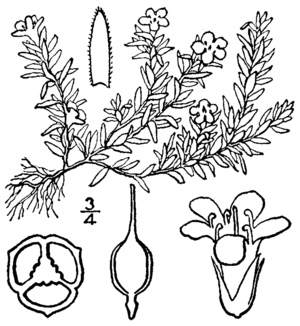Flowering pixiemoss facts for kids
Quick facts for kids Flowering pixiemoss |
|
|---|---|
 |
|
| Conservation status | |
| Scientific classification | |
| Genus: |
Pyxidanthera
|
| Species: |
barbulata
|
The flowering pixiemoss, also known as Pyxidanthera barbulata, is a small and unique flowering plant. It belongs to the Diapensiaceae family. You can find this plant growing naturally in the eastern United States. It lives along the coast, from Long Island in New York, down to New Jersey, Virginia, and South Carolina.
Contents
What is the Flowering Pixiemoss?
Even though it's called "pixiemoss," Pyxidanthera barbulata is actually not a moss at all! It's a type of low-growing plant called a subshrub. This means it's a small, woody plant that stays close to the ground. It forms a thick mat, almost like a carpet, on the soil.
How the Pixiemoss Grows
This special plant grows from a part called a rhizome. A rhizome is like an underground stem that helps the plant spread. Its stems also grow roots at different spots where they touch the ground. This helps the plant create new growth and cover more area.
The leaves of the flowering pixiemoss are very close together. They are shaped like a spear, which is called lance-shaped. Each leaf is usually less than one centimeter long.
Flowers of the Pixiemoss
The flowers of the pixiemoss are quite small and pretty. They have pink sepals, which are like small leaves that protect the flower bud. The petals, which are the colorful parts of the flower, are white. Each petal is about half a centimeter long.
Where Does the Pixiemoss Live?
The flowering pixiemoss likes to grow in dry, sandy soils. You can often find it under pine trees. Even though it can sometimes be found in wetlands, it is very good at living in dry places.
Surviving Wildfires
This plant is also well-suited to areas that often have wildfires. It has special ways to survive and even thrive after a fire. You can find the flowering pixiemoss in several unique habitats:
- Pine barrens: These are areas with sandy soil and pine trees.
- Flatwoods: These are flat, wooded areas, often with pine trees.
- Sandhills: These are small, sandy hills.
- Edges of pocosins: Pocosins are a type of wetland found in the southeastern United States.
See also
In Spanish: Pyxidanthera barbulata para niños


